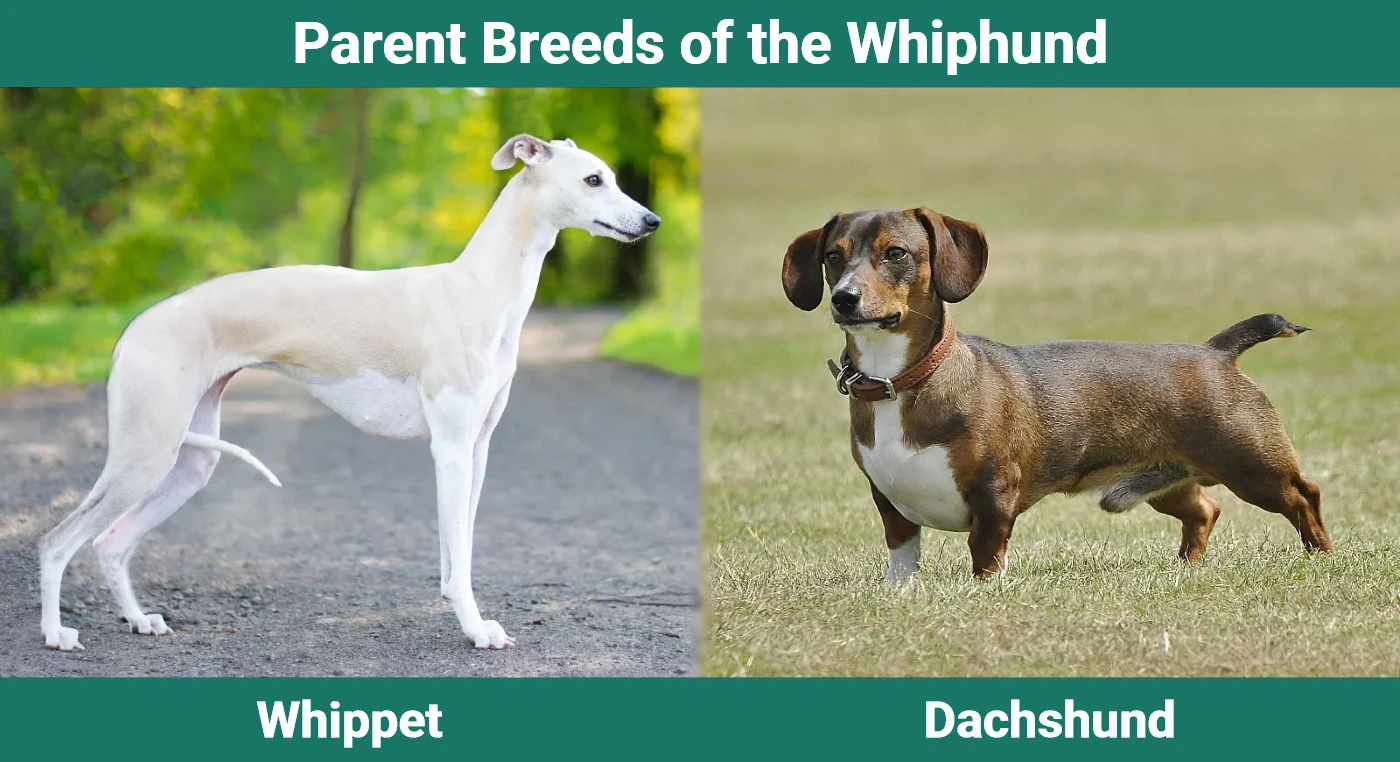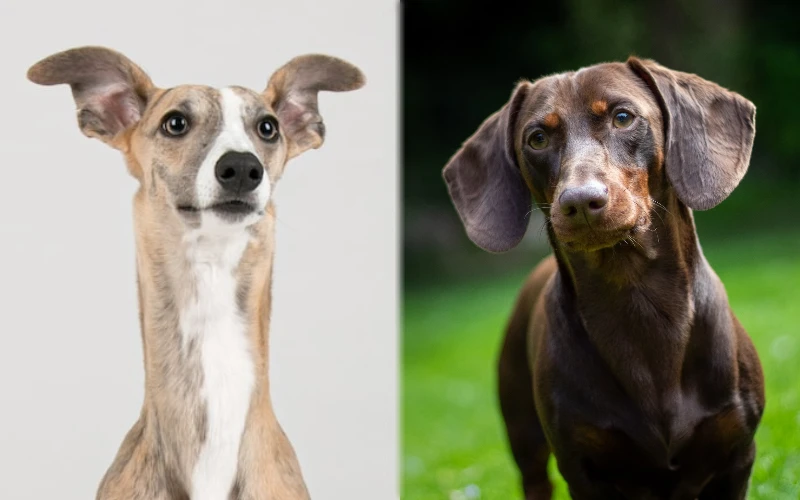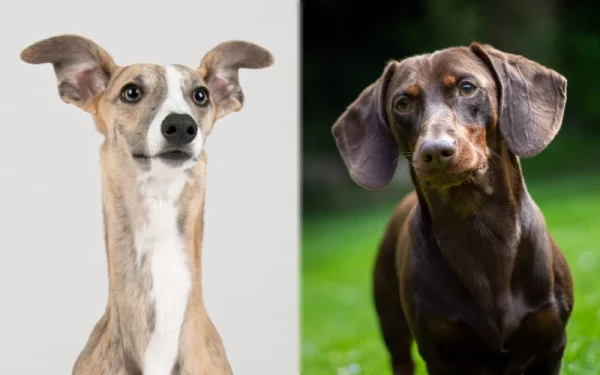Click Below to Skip Ahead
When the speedy Whippet and the adorable Dachshund are combined, the result is the Whiphund. The Whiphund is a unique mixed breed that ranges from small to medium in size, and they are typically smooth-coated. While some may appear to be a balanced mix between their parent breeds, others have a stronger resemblance to either the Whippet or the Dachshund.
Breed Overview
Height:
8–22 inches
Weight:
16–40 pounds
Lifespan:
12–16 years
Colors:
Black, blue, red, cream, sable, brindle, fawn, seal
Suitable for:
Moderately active families, families that want a low-shedding dog, affectionate families
Temperament:
Friendly and affectionate, inquisitive, and playful
As a mixed breed, the personality of your Whiphund can be difficult to predict. Both parent breeds are affectionate, playful dogs, so the Whiphund is almost certain to be the same. However, your Whiphund’s energy levels may differ slightly, as the Whippet tends to be more lively than the Dachshund.
Whiphunds have friendly dispositions, making them excellent family pets. Some may be eager to play with young children and other dogs, whereas others may be slightly more reserved. To decide whether or not this mixed breed is right for you, scroll down to learn about their temperament, needs, and other related facts.
Whiphund Characteristics
Whiphund Puppies
The Whiphund is an excitable, energetic puppy with an inquisitive nature. They will want to race around their new home and poke their nose into everything, so make sure your house is puppy-proofed before bringing them home. While most puppies tend to mellow out with age, the puppyish energy your Whiphund will retain can be challenging to predict. Some settle down, while others constantly need to run and play.
Finding a Whiphund may be a challenge. Shelters aren’t likely to know the history or parent breeds of the dogs in their care, and breeders primarily raise purebred dogs rather than hybrid breeds. Searching for a breeder specializing in Whiphunds will take time and patience, but it may be your best shot at locating a Whiphund.

Temperament & Intelligence of the Whiphund
Whiphunds are affectionate, playful companions. While other areas of their personalities may differ, the one area that they are consistent in is their friendly dispositions. They love their people and enjoy spending time with them, whether that involves curling up on the couch or going for a brisk walk.
Dachshunds are a vocal breed that barks at every given opportunity. However, Whippets bark only when necessary. Therefore, your Whiphund may range from noisy to quiet.
While both parent breeds are friendly, the Whippet is more reserved around strangers. Even though your Whiphund will likely greet strangers with a curious, welcoming sniff, how eager they are to meet unfamiliar people will vary.
Whiphunds are intelligent dogs, though occasionally self-willed. Early obedience classes and socialization will be essential to raising a well-mannered pet.
Are These Dogs Good for Families?🏡
Whiphunds are happy companions who love to spend time with their families. Their playful energy can make them great companions for children and active adults. Whippets get along spectacularly with young kids, whereas Dachshunds can sometimes become overwhelmed by their presence.
Socializing your Whiphund may help reduce their stress in the presence of younger children, and teaching your kids proper boundaries will help keep them safe.
Does This Breed Get Along With Other Pets?🐶 😽
Whiphunds often get along with other pets well. Both parent breeds are excellent with other canine companions; however, if your Whiphund takes after the Dachshund in size, not all dog breeds will mesh well with your Whiphund. Large-breed dogs may be too big for a smaller Whiphund.
At the same time, smaller mammals are not recommended for the Whiphund. The Whippet and the Dachshund were bred for hunting, so their prey drives may make it difficult to cohabitate with a smaller creature.
Things to Know When Owning a Whiphund
Before searching for a Whiphund, there are some things you should know about caring for them. Below, we will discuss the care requirements for a Whiphund’s diet, activity levels, training, and grooming. We will also take a look at the common health conditions you should be aware of, as well as any differences between males and females.
Food & Diet Requirements🦴
Feeding your Whiphund a balanced, high-quality diet that is certified by the American Association of Feed Control Officials (AAFCO) will keep your pet healthy. To ensure your pet thrives on a healthy diet, talk to your veterinarian to develop a diet plan.
You must watch your Whiphund’s weight, as both the Whippet and the Dachshund can suffer serious health issues if they become overweight. Excess weight can strain a Whippet’s frail frame and the Dachshund’s long back, which can lead to slipped or herniated discs.
Exercise🐕
While the Whiphund can be a lively dog, they don’t require rigorous exercise. Depending on your Whiphund’s energy levels, around a half hour to an hour of activity each day should be sufficient. If your Whiphund is built more like a Whippet, activities that involve short bursts of speed are ideal.
Whippets love to sprint, and they’re good at it! Setting up agility courses or playing fetch can be a great way to give your Whiphund exercise. On the other hand, if your Whiphund looks more like a Dachshund, sprints won’t be appropriate for their short stature and stubby legs. In fact, that sort of activity can put a strain on their body. Instead, focus on brisk walks or other less rigorous activities.
Training🦮
Whiphunds are intelligent dogs that can be a pleasure to train. At the same time, both parents are known for their occasional bouts of attitude. Whippets can be easily distracted and decide that they are more interested in exploring (or even escaping) than training. Dachshunds can be stubborn.
Still, both breeds are eager to spend time with their owners, so allowing your Whiphund to feel like they are participating in something fun with you can make the training process easier. Similarly, Whiphunds are sensitive dogs, so negative reinforcement or punishments are not advised. Instead, focus on rewarding your dog for the good things they do rather than focusing on the negatives.
Grooming ✂️
Since the Whiphund often has a short, smooth coat, they don’t require much grooming. Weekly brushing and an occasional bath will be sufficient to keep your dog looking their best. Neither Whippets nor Dachshunds shed often, and you won’t have to clean up loose hair as often as you would with other breeds.
However, some Dachshunds can have medium-length coats with varying hair textures. If your Whiphund inherits a coat like that, you’ll need to brush their hair more frequently.
- You might also be interested in: Best Dog Wipes: Reviews & Top Picks
Health and Conditions❤️
Whiphunds may be predisposed to conditions the parents are prone to developing. While Whippets and Dachshunds tend to be healthy, there are some serious conditions you should be aware of.
One such condition is von Willebrand disease, a blood disease in which platelets struggle to form clots to patch over a broken vessel. Another serious issue is gastric dilatation and volvulus, or GDV. GDV occurs when your dog’s stomach becomes bloated with gas, becoming so inflated that it flips and twists, preventing gas from escaping.
This medical emergency can rapidly become fatal, so catching the signs early on is essential. Mitral valve disease is a heart condition in which the mitral valve degenerates, causing a dysfunction in proper blood flow through the heart. As for relatively minor conditions, you will want to watch for ear infections, dental problems, and luxating patellas (dislocated knees).
- Luxating patella
- Dental disease
- Ear infections
- Von Willebrand disease
- Gastric dilatation and volvulus
- Mitral valve disease
Male vs Female
The main difference between a male and female Whiphund is their size. However, it can depend on the parent breed your Whiphund most takes after, as a female Whippet will be larger than a male Dachshund.
3 Little-Known Facts About the Whiphund
1. Whippets Are Fast Runners
Whippets are world-champion sprinters. Some can even reach speeds as high as 35 miles per hour!
2. Dachshunds Can Have Three Types of Coats
Many Dachshunds have short, smooth coats, but that is not always true. The Dachshund’s three main coat types include smooth, longhaired, and wirehaired.
3. Dachshunds Can Live a Long Time
The average lifespan of a Dachshund is 12–15 years. However, some Dachshunds have been known to live even longer. Several Dachshunds have broken the world record for the oldest living dog. One Dachshund named Chanel lived to be 21 years old, and another named Scolly lived to be 20 years old.
Final Thoughts
If you are looking for an energetic and playful companion, the Whiphund is a great choice. Whiphunds make excellent family dogs due to their friendly dispositions and desire to be around their favorite humans.
Your Whiphund’s personality may vary slightly depending on which parent they take after most. For example, Whippets require a lot of exercise, while Dachshunds are more moderate in their activity needs. At the same time, Whippets are quiet, whereas Dachshunds bark at any opportunity.
To keep your Whiphund healthy, carefully monitor their caloric intake to avoid obesity and provide daily exercise suitable to their physical frame. Likewise, review their common medical concerns so that you can recognize the signs if they should appear.
The Whiphund is a great companion for families with young children and other dogs. If you think the Whiphund is the right fit for your household, search your local animal shelter or research breeders nearby to find your forever friend.
See Also:
- Whipoodle (Whippet Poodle Mix): Pictures, Care, Info & More
- Whippet Border Collie Mix: Pictures, Care, Info & More
Featured Image Credit: Left – S J, Unsplash | Right – Hayden Patmore, Unsplash











